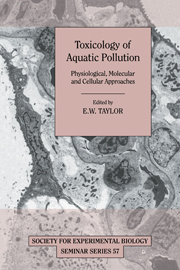Book contents
- Frontmatter
- Contents
- List of contributors
- Preface
- Water chemistry at the gill surfaces of fish and the uptake of xenobiotics
- Bioaccumulation of waterborne 1,2,4,5-tetrachlorobenzene in tissues of rainbow trout
- Dietary exposure to toxic metals in fish
- The physiology and toxicology of zinc in fish
- Lethal and sub-lethal effects of copper upon fish: a role for ammonia toxicity?
- The physiological status of brown trout exposed to aluminium in acidic soft waters
- Physiological and metabolic costs of acclimation to chronic sub-lethal acid and aluminium exposure in rainbow trout
- Physiological effects of nitrite in teleosts and crustaceans
- Metallothioneins in fish: induction and use in environmental monitoring
- Oestrogenic substances in the aquatic environment and their potential impact on animals, particularly fish
- Effect of genetic toxicants in aquatic organisms
- In vitro toxicology of aquatic pollutants: use of cultured fish cells
- Principles governing the use of cytochrome P4501A1 measurement as a pollution monitoring tool in the aquatic environment
- Index
Bioaccumulation of waterborne 1,2,4,5-tetrachlorobenzene in tissues of rainbow trout
Published online by Cambridge University Press: 20 May 2010
- Frontmatter
- Contents
- List of contributors
- Preface
- Water chemistry at the gill surfaces of fish and the uptake of xenobiotics
- Bioaccumulation of waterborne 1,2,4,5-tetrachlorobenzene in tissues of rainbow trout
- Dietary exposure to toxic metals in fish
- The physiology and toxicology of zinc in fish
- Lethal and sub-lethal effects of copper upon fish: a role for ammonia toxicity?
- The physiological status of brown trout exposed to aluminium in acidic soft waters
- Physiological and metabolic costs of acclimation to chronic sub-lethal acid and aluminium exposure in rainbow trout
- Physiological effects of nitrite in teleosts and crustaceans
- Metallothioneins in fish: induction and use in environmental monitoring
- Oestrogenic substances in the aquatic environment and their potential impact on animals, particularly fish
- Effect of genetic toxicants in aquatic organisms
- In vitro toxicology of aquatic pollutants: use of cultured fish cells
- Principles governing the use of cytochrome P4501A1 measurement as a pollution monitoring tool in the aquatic environment
- Index
Summary
Introduction
During the past three years we have been studying the rates of uptake by fishes of selected synthetic organic chemicals, foreign to natural systems, known as xenobiotics. We have conducted several tests using an automated respirometer in which we have exposed fish to 1, 2, 4, 5-tetrachlorobenzene (TCB). Our principal test animal has been the rainbow trout (Oncorhynchus mykiss), although we have also tested other fish species to compare results. One of our long-range objectives is to determine to what extent uptake and depuration rates of xenobiotics by fishes may be related to their respiration rates. Using that information, we are working toward developing a simple predictive model to describe the rates of uptake and depuration of xenobiotics as a function of the oxygen uptake rate and chemical properties of the chemical in question. Some of our laboratory research, and our progress to date on developing the predictive model, are reported in Chapter 1, Randall et al. (1995). In the present paper, we will provide details of the methods used while conducting our respirometry experiments, and also provide results of some of the other experiments conducted during early stages of our study.
Methods
Test conditions
Many of our preliminary tests were conducted at Fisheries Bioassay Laboratory, Montana State University (MSU), and most of our respirometry experiments were conducted in a modified Brett-type respirometer at the Zoology Department, University of British Columbia (UBC). All fish tissue and water analyses were conducted at MSU. The UBC respirometer was designed and built specifically for our studies, and has been described in some detail by Gehrke et al. (1990).
- Type
- Chapter
- Information
- Toxicology of Aquatic PollutionPhysiological, Molecular and Cellular Approaches, pp. 17 - 28Publisher: Cambridge University PressPrint publication year: 1996



